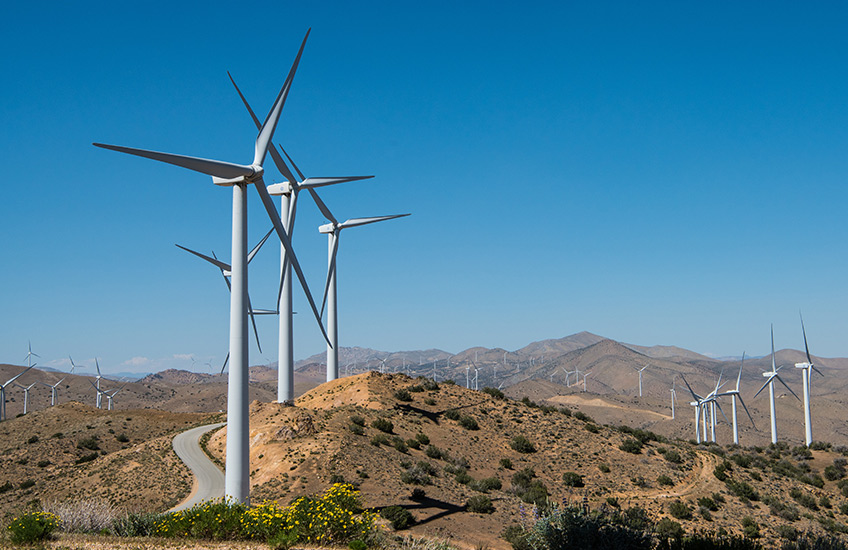When the Gears Stop Turning
NREL and PG&E Collaboration Demonstrates Synthetic Inertia
When a power system’s frequency deviates from the norm, the world keeps turning, and the power stays on. More specifically, large mechanical gears in a traditional power system keep turning, serving to resynchronize frequency to its functioning value—50 or 60 hertz.
In places like northern California, however, where Pacific Gas and Electric Company (PG&E) customers are switching to gearless renewable energy resources like solar photovoltaics, and traditional power plants with spinning gears are starting to be retired, there is uncertainty as to whether the remaining gears can keep pace. PG&E is collaborating with the National Renewable Energy Laboratory (NREL) to explore how emerging energy sources can bear the burden of their own frequency dynamics by providing so-called “synthetic inertia.”

Renewable energy resources like solar photovoltaics and wind turbines lack the mechanical inertia traditionally used by power systems to balance frequency. NREL and PG&E are collaborating to understand stability of inverter-based systems of low- or zero-inertia. Photo by Dennis Schroeder
Inertia, referring to the inertial kinetic energy that propels rotating generators, has been essential to stabilizing power grids since the earliest electrical systems. Without inertia, a frequency that deviates even modestly from operating value could send power systems into cascading failures. A system with synthetic inertia would need to digitally control the same balancing act traditionally performed by mechanical means.
However, synthetic inertia control algorithms are new tools, and it’s unclear exactly how they will perform within PG&E’s network of the future. To find out, engineers at NREL’s Energy Systems Integration Facility will first develop a realistic model of PG&E’s power grid and examine how the system will respond to low-inertia conditions that may occur once traditional generators have retired and been replaced by inverter-interfaced resources (e.g., wind, photovoltaics, battery storage). These simulations will help PG&E understand when the utility system might begin to experience reliability issues caused by a shift in generation resources.
Next, NREL and engineers from the National Wind Technology Center will develop synthetic inertia controllers for the wind, photovoltaics, and battery storage resources. These controllers will be put to the test and evaluated against simulated low-inertia scenarios. Finally, an inverter on NREL’s 1-megawatt battery energy storage system (BESS) will be programmed to provide synthetic inertia capabilities. A team led by NREL’s Chief Engineer Vahan Gevorgian will connect the BESS in-loop to test scenarios—situations that are physically identical to those that PG&E will hypothetically face. Results from BESS will supplement the simulated findings to produce a more refined model of synthetic inertia.
The combination of advanced modeling, simulation, and hardware testing will ultimately inform one of the first-ever, large-scale synthetic inertia demonstrations. NREL’s capacity to model any contingency situations—say, three inertial systems removed from PG&E’s power system with the addition of synthetic inertia from renewables and a large-scale BESS—gives an unprecedented perspective of how future technology will perform at scale on PG&E’s system.
“We are excited to answer questions that are becoming more and more urgent to industry,” said NREL’s Yingchen Zhang, the project’s principal investigator. “What will system dynamics look like when predominated by inverter-based generation? And can the inverter controllers do anything to mitigate that change and the impact on system stability?”
PG&E is not alone in exploring synthetic inertia. It’s just ahead of the curve. Low inertia will be a common characteristic of future grids, and mitigation of its impact will be a priority. This project will make new strides toward developing the control algorithms and simulation tools needed to assess solutions for different low-inertia scenarios. To prepare for this low- or even zero-inertia reality, PG&E is dedicating funds from the Electric Program Investment Charge (EPIC) program, which allows California’s investor-owned utilities and the California Energy Commission to execute demonstration and deployment projects for emerging grid technologies.
“PG&E expects continued growth of renewable energy resources and battery storage, and eventual retirement of traditional spinning generation, making it essential to plan thoughtfully and develop new technologies and techniques to operate our system with significantly less conventional inertia,” said Janice Berman, director of grid innovation at PG&E. “As operator of the evolving electric grid system, we believe it is important to invest in the development of new tools, like synthetic inertia, that will be required in the future to keep providing safe, reliable, affordable, resilient, and clean power as the complexity of the grid continues to grow."
The project concluded in 2018.
Last Updated May 28, 2025
